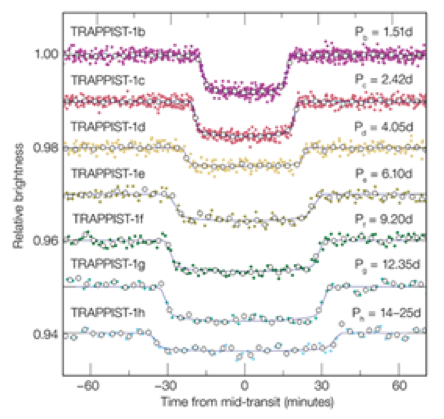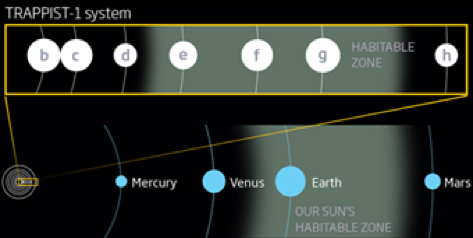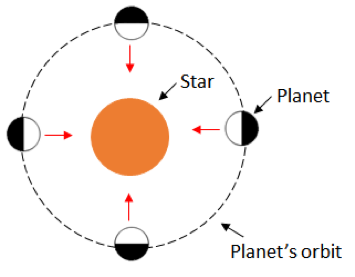This blog entry has been written by Ellie Kershenbaum, a student from Sawston village college.
In February 2017, the University of Liège and the University of Cambridge announced that about 39 light years away there is a system of seven Earth-sized planets orbiting an ultra-cool dwarf star called TRAPPIST-1. This discovery made news all over the world and for good reason. All planets in this system are temperate, meaning they are under certain geologic and atmospheric conditions to potentially host liquid water, although three are thought to receive the right temperature from the star to sustain water in liquid form. This suggests that there is a possibility that extra-terrestrial life exists there! The host star is only about 8% the mass of the Sun and is not much bigger than Jupiter.
All the planets in this system are called exoplanets. These are planets outside of our Solar System that orbit a star. The study of exoplanets is a very fast-moving and relatively new field. The first confirmed detection of an exoplanet was in 1992, while the first detection of an exoplanet orbiting a main sequence star (a Sun-like star) did not occur until 1995, and was made by Michel Mayor and Didier Queloz. There are many reasons why we should find and observe exoplanets. One reason is that we have to observe exoplanets in order to look for signs of extra-terrestrial life. Dr Sylvestre Lacour, a visiting astronomer at the Battcock Centre for Experimental Astrophysics, works on a small satellite called PicSat (1) that will detect exoplanets from space. He says that observing exoplanets can give us a better understanding of how planets form, by looking at different exoplanets and identifying different stages of a planet’s life. He also suggests that observing exoplanets could predict what could happen to the Earth in the future, for instance, the effects of climate change.
TRAPPIST-1 was discovered using transit photometry, which involves detecting a small regular loss of light emitted by a star, which shows that a planet has crossed the star as it moves along its orbit, blocking a small fraction of the light from reaching us. This is known as a transit. The larger the dip in light is, the more of the surface of the star the planet has covered, and therefore the bigger the planet is. This method has proven useful in detecting exoplanets, however there are some problems with it. For example, background noise, and changes in the activity of the star can slightly change the amount of radiation that is detected. This means that it is more difficult to detect the small, regular dips of light from the planet transiting.

There are other methods of detecting exoplanets. For instance, the gravitational pull of the planet orbiting the star causes the star to wobble. The radial-velocity method detects the blue shift (when the star moves closer to us) and the red shift (when the star moves away from us) of a star as it wobbles. One problem with this method is that the red/blue shift could actually be caused by a star that is further away, rather than a planet. Another method for detecting exoplanets is direct imaging. This consists of taking images of a planetary system to see if there are planets orbiting the star. The problem with this method is that the planet could be difficult to see, as the parent star’s light could overpower it. Therefore, it is only viable for bright planets in distant orbits around nearby faint stars. I spoke to Dr Samantha Thompson, a research associate from the Battcock Centre, who mainly works on the development of new instruments and techniques to detect and characterise exoplanets. She believes that developing high-contrast imaging, for the direct imaging method of detecting and characterising exoplanets, is extremely important and useful. This is because direct imaging is a potent way of characterising exoplanets. Rather than inferring characteristics (e.g. size, distance from star), as transit photometry and the radial velocity method do, direct imaging allows us to see them directly. High-contrast imaging, such as coronagraphy (viewing objects near a star by blocking its bright surface), would suppress starlight and preserve planet light. This would enable us to see the planet and its characteristics more clearly.
The inner three planets, TRAPPIST-1b, TRAPPIST-1c, and TRAPPIST-1d are thought to be too close to the star, so the heat energy from the star would evaporate any water. Similarly, the outermost planet, TRAPPIST-1h, is thought to be too far from the star, so the water would solidify, however, internal heating, caused by tidal friction between the planet and star, may increase the chances of liquid water. Three of the seven planets, TRAPPIST-1e, TRAPPIST-1f, and TRAPPIST-1g, are described as being in the Habitable Zone. The Habitable Zone, or Goldilocks Zone, is the distance from the star at which water can exist in liquid form as it is not too close or too far from the star.

Density measurements suggest that at least six of the seven planets are probably rocky in composition, which gives a better chance of life existing there. The low density of TRAPPIST-1f suggests it might have a volatile-rich composition (chemical compounds and elements with low boiling points) which could be in the form of an ice layer and/or an atmosphere. The planets in the system are all Earth-sized (except TRAPPIST-1d and TRAPPIST-1h which are between the sizes of Mars and Earth) and have a similar mass to Earth. The mass of a planet is not as simple to calculate as some other features such as its diameter when using transit photometry. However, there is a way of estimating the mass. Dr Amaury Triaud, a Kavli Exoplanet fellow at the Institute of Astronomy, is a co-author on the key paper recently published about the TRAPPIST-1 system (2). He explains that the mass of an exoplanet can be estimated by looking at the effect it has on other planets. The gravitational force of a planet can accelerate or decelerate another planet’s orbit which will make it transit slightly late or slightly early. This can be used to estimate a planet’s mass.
It may seem strange that a system with an ultra-cool dwarf star (a star that’s very different from our own) would be host to Earth-like planets, with chances of life, but it’s not. It’s been suggested that instead of trying to look for a system identical to ours we should start to look for different systems such as dwarf planetary systems. This is because the stars that are like our Sun represent only 15% of the stars in the Milky Way, more than half of those being in binary systems (a system in which two stars orbit around a common centre of mass, gravitationally bound to each other). Our star is therefore relatively unusual, and does not represent the other stars in the Milky Way. Another reason we should be looking at dwarf planetary systems is that it may be more likely for a rocky planet to orbit a low-mass star. Furthermore, transits are more prominent with a smaller star as the planet will block a larger fraction of light, meaning it is easier to detect. With a smaller star, transit periods are shorter as the orbits are closer, which also means it is more likely that we will be able to detect a transit. The more transits we can detect of the same planet, the more confident we can be about the properties of that planet.
Now for the big question, is there life on these planets? As well as having many orbiting planets, TRAPPIST-1 probably got a lot of news coverage because of the possibility of life existing there. This is a very exciting topic that makes us think of all the science fiction films, TV shows, and books. It’s important for us to try to expand our knowledge about life in the universe as it could give us a clue to how life began on Earth. There are a lot of factors that play a big role when it comes to the possibility of life. For example, the composition of the atmosphere. Detecting certain gases and chemical compounds in the atmosphere, such as carbon monoxide, water, or oxygen, would tell us how habitable the planet is, and how likely it is for life to evolve there. The detection of biologically produced gases in the atmosphere, such as methane, could be indicative of life. However, some indicators can be misleading. For instance, repeated stellar flares could result in oxygen in the atmosphere. The likelihood of life also depends on whether the planet is rocky, which can be determined by calculating its mass and volume, looking to see if the planet is relatively dense. However, it is possible that the planets (at least the ones closer to the star) are tidally locked, so that they don’t rotate, meaning that each point on the surface has either constant day or constant night. This could lead to one side of the planet being too hot to support life, and one too cold, which means life could only evolve at the rim that connects the dark and light side.

This discovery is very important for astrophysics and astrobiology, but there are still things that we don’t know or can’t be sure about, for instance the chemical composition and atmospheric structures of the planets. For this reason, the James Webb Space Telescope, which will launch in 2018, and the Hubble telescope, will collect further observations on the TRAPPIST-1 system from space. There are also plans of finding more Earth-like exoplanets in dwarf planetary systems, including ultra-cool dwarf stars.
So, why should we care about this system? The TRAPPIST-1 system could improve our understanding of star and planet formations and is an important target for the search for extra-terrestrial life, to further our understanding of the conditions that life requires. Dr Triaud suggests that the discovery of TRAPPIST-1 could indicate how common life is in the universe. We might be unique and rare, or surrounded by thriving alien life we just haven't detected yet. There has been increasing evidence to suggest that Earth-like planets are not that uncommon. NASA’s Kepler space telescope has already released a recent mission catalogue which includes 219 new planet candidates, 10 of which being near-Earth size and orbiting in their star's habitable zone (4). If Earth-like planets in the habitable zone are not extremely rare, maybe life isn’t either. The TRAPPIST-1 system could also lead to other discoveries, constantly improving the instrumentation we use and the knowledge we have of our universe. So we probably should care.
(1) https://picsat.obspm.fr/picsat/
(2) https://www.nature.com/nature/journal/v542/n7642/full/nature21360.html

